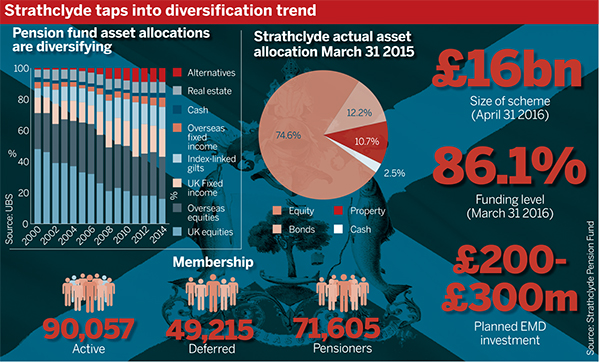Strathclyde Pension Fund has approved a range of investment changes, including up to £300m in emerging market debt and £30m in core UK infrastructure.
Many defined benefit schemes are approaching the point at which they move from positive to negative cash flow. This is a natural part of the life of a scheme, but will necessitate changes in investment strategy.
The £16bn Strathclyde Pension Fund is one of those schemes that have reached the tipping point, and is adjusting its investments as a result.

The changes were approved in a meeting of the pension fund committee last week. They include “initiating a process” to invest £200m-£300m in emerging market debt, £30m in core UK infrastructure as part of its direct investment portfolio, reducing its allocation to gilts and increasing the UK and US credit allocation.
Jacqueline Gillies, chief investment officer at the fund, said the scheme wants to start investing in emerging market debt “because it offers some diversification and also good relative value”.
She continued: “While returns from most classes are expected to be low in the current environment, EMD is one of a number of strategies that can provide reasonable absolute returns.”
With infrastructure, however, she said “the potential for steady and attractive long-term return is something that suits us”.
Strategy shift
The committee agreed in March last year to adopt a risk-based asset framework when agreeing investment strategy. The current changes are the implementation of the framework and will take place over the next few months.
“The overall strategy is very much biased towards growth but… the fund is currently at a tipping point where pensioner and deferred liabilities have just begun to outweigh active-member liabilities, and cash flow from members is shifting from a net income figure to a net outflow,” Gillies said.
This will lead to increased focus on risk reduction and diversification, she added.
As part of this, the fund will sell out of gilts entirely, to be replaced by credit investments. It already holds some UK credit and will add US credit.
Gillies said while the fund’s gilt allocation was technically 3 per cent, its actual exposure was much lower at less than 1 per cent.
Emerging market debt
David Furey, senior portfolio manager at investment manager State Street Global Advisers, said emerging market debt had experienced “a significant increase in interest”, spurred in part by low yields on offer in developed economies.
He said investors from developed economies other than the UK face more pressure. “The pressure isn’t the same for UK investors, but gilts are printing new lows.”
Furey said the nature of emerging market debt makes it likely to be on the growth side of a portfolio. “EM debt has to be very long-term in nature,” he said. “It can be volatile. It’s more likely [to] sit in the growth part of the portfolio.”
Emerging market debt is typically chosen by large investors, Furey said; active managers are the primary way investors have accessed the asset class.
Infrastructure
Strathclyde’s £30m infrastructure investment will go into a fund run by manager Equitix, which will invest in a combination of development and secondary assets, aiming to generate a steady cash yield over the life of the fund’s assets.
It will form part of the Strathclyde fund’s £780m direct investment portfolio, where it already holds some infrastructure alongside other assets. Gillies said that while the main focus of the portfolio was investment quality and return, “we’re also interested in a wider impact where that is possible”.
Hans Holmen, principal consultant at Aon Hewitt, said infrastructure had been appealing for pension schemes for a long time. “There has always been reasonably strong interest from UK plans. The attractiveness is the breadth of investments,” he said.
However, he said that demand for core assets has led to pricing pressure.














